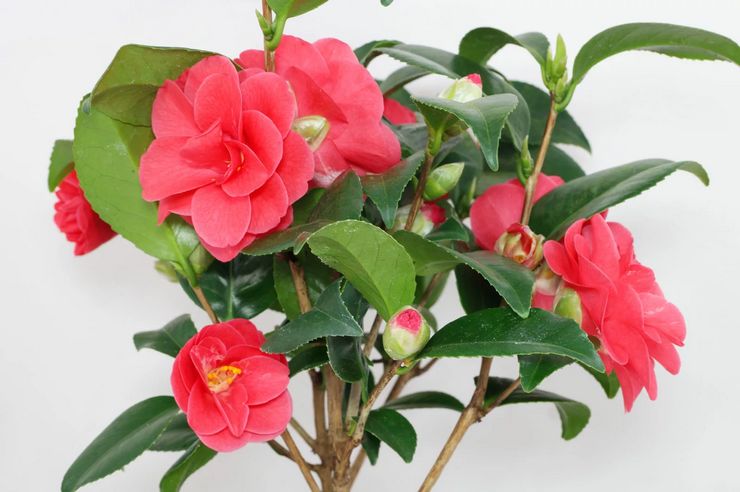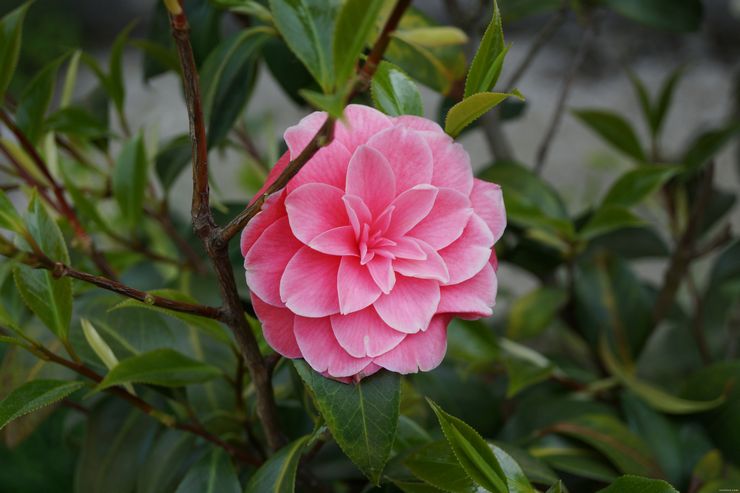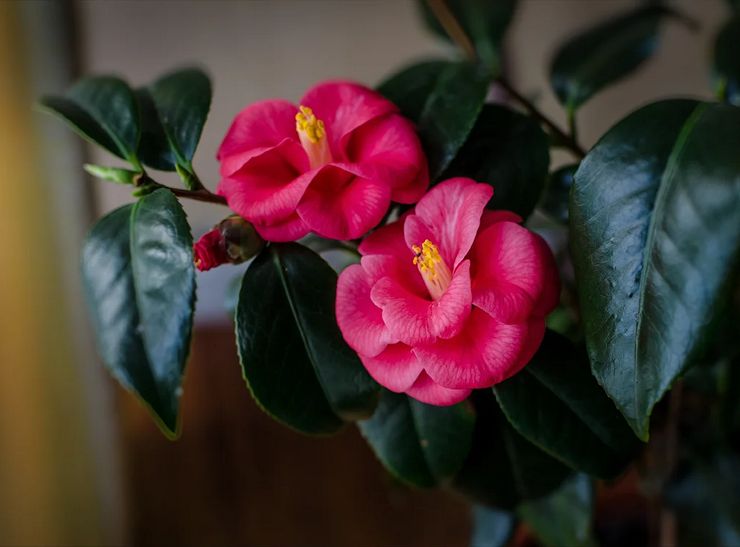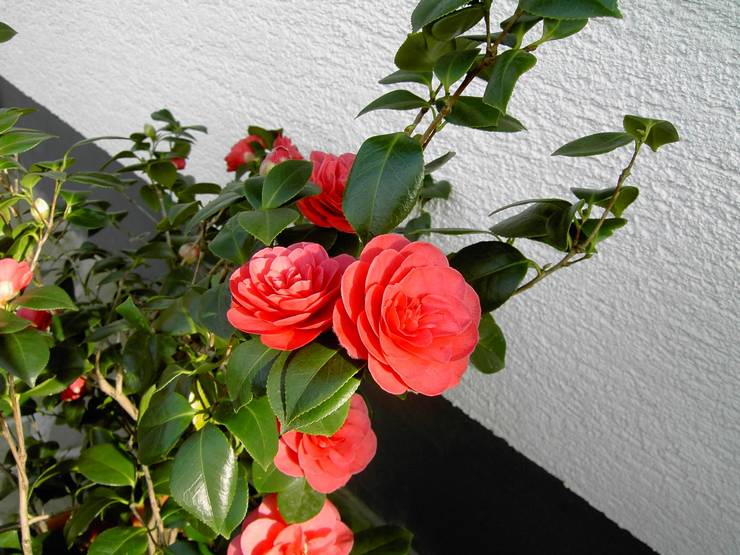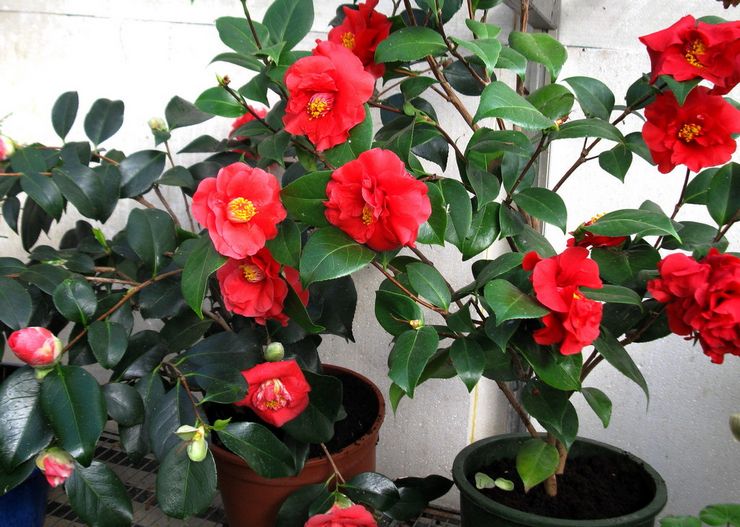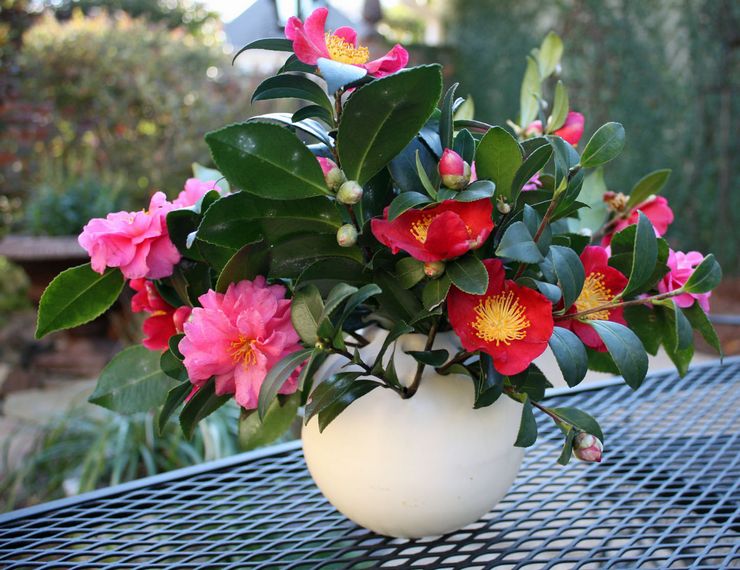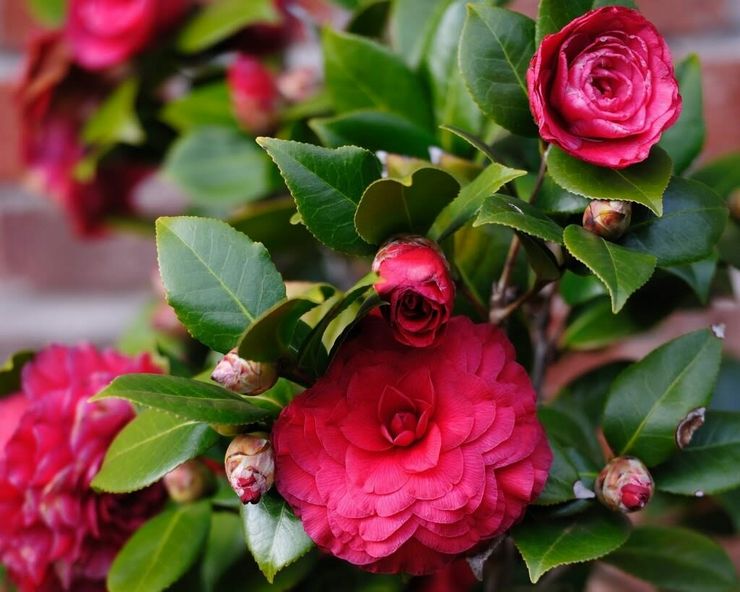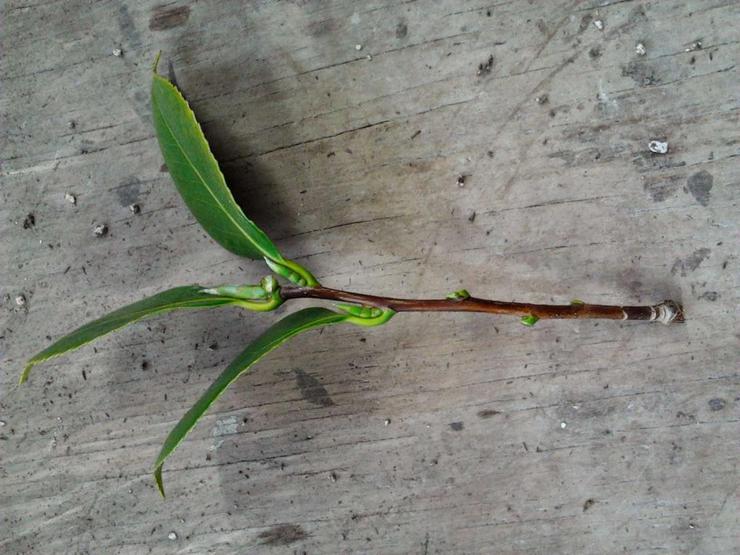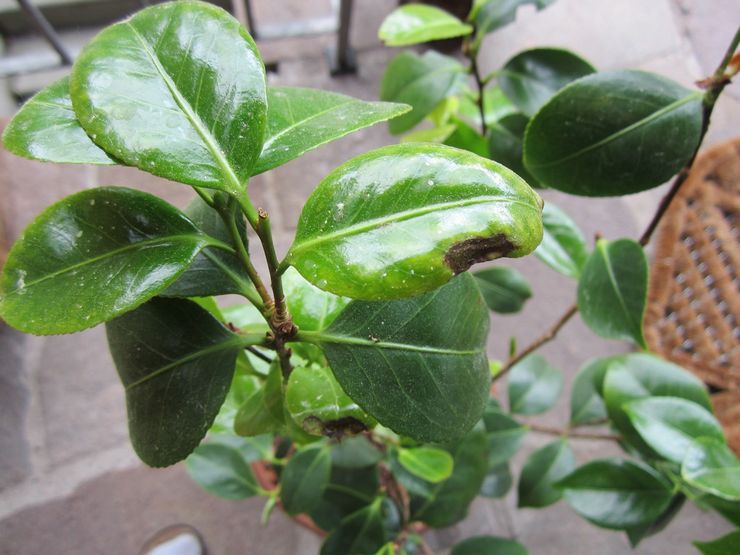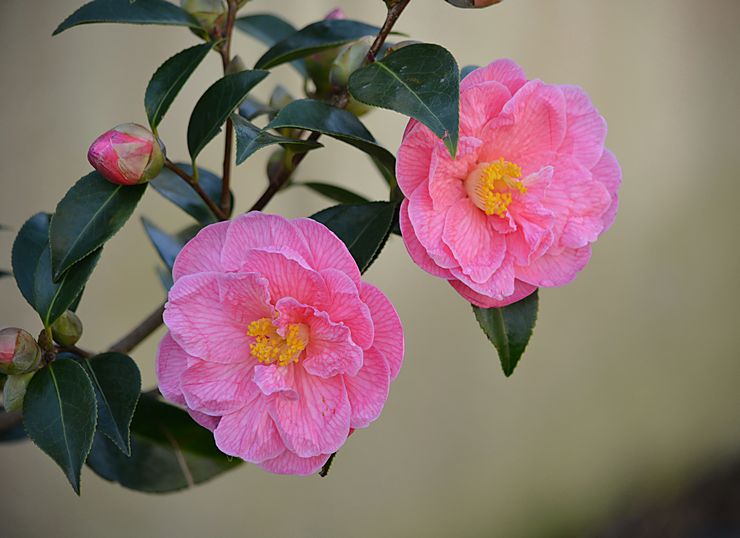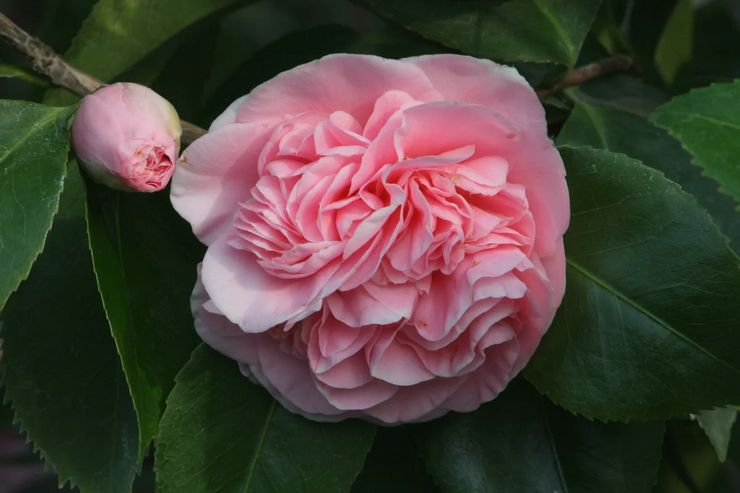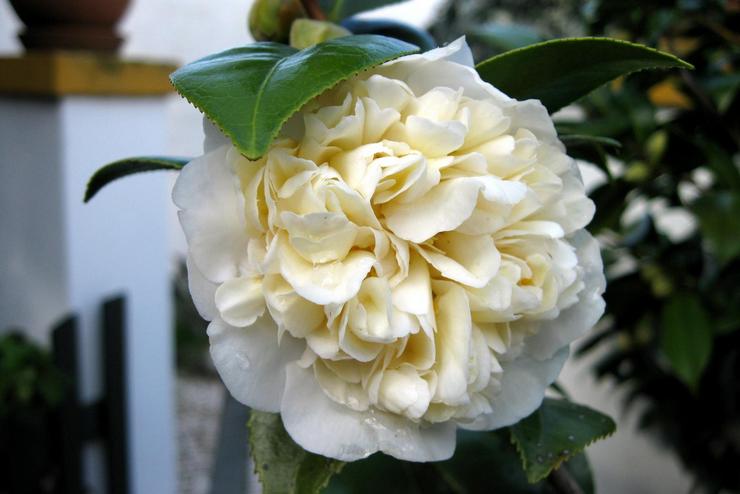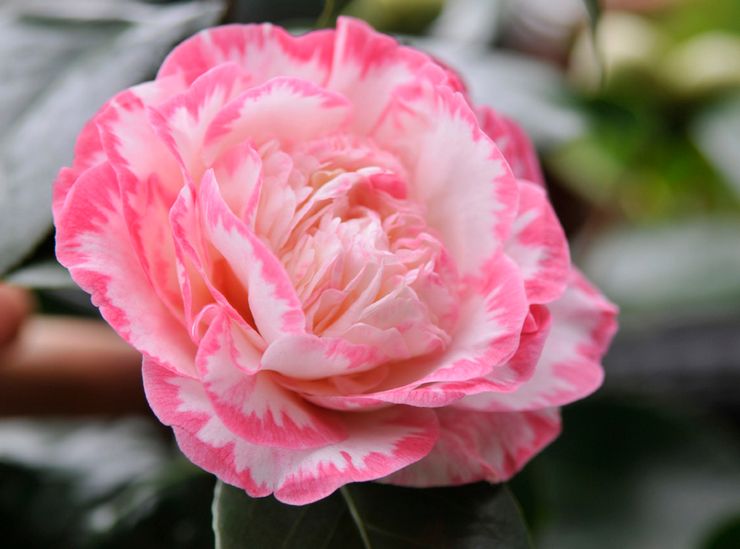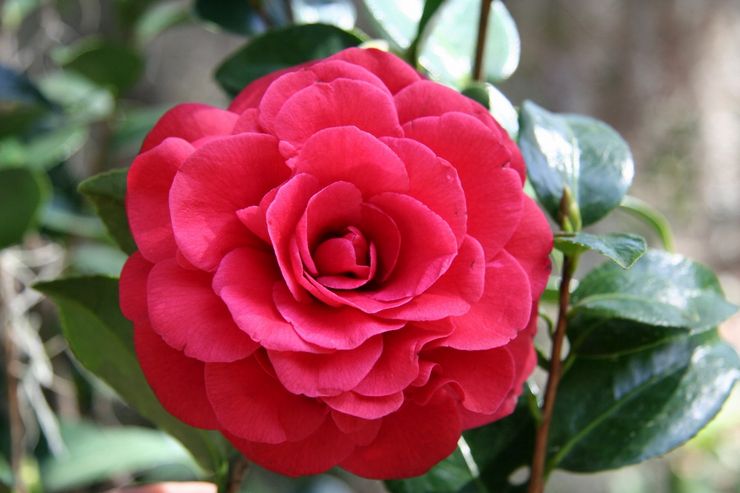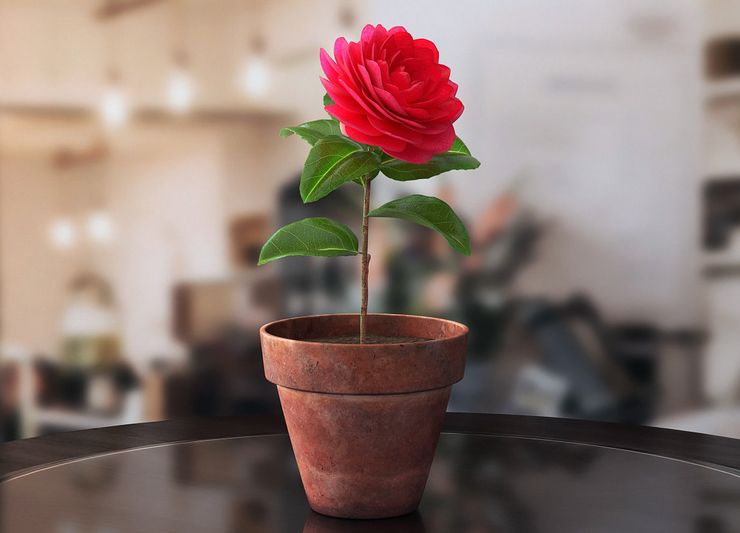Camellia (Camellia) is a flowering plant from the Tea family. It can grow as an evergreen shrub or small tree. In nature, the flower is found in Asia and the Philippines. Camellia can be kept at home. She prefers large spaces, plenty of light and coolness. Only Japanese camellia is grown as a houseplant. There is also Chinese camellia, but, as you know, it is a type of tea..
Description of camellia
Camellia is a shrub or small tree. The height of a shrub can reach 50 cm, and a tree – 3 m. The plant has glossy leathery leaves of a rich dark green color. The leaf plates are located on short petioles, they have an ovoid shape, the tips can be sharp or rounded. The length of the leaves is 6-8 cm. The flowers have a diameter of 4 to 15 cm, their color is most often red, pink or white, variegated varieties are found. The shape of the petals is round or wide oval. In the center of the opened buds there are many stamens.
Japanese camellia – secrets of care and maintenance at home. Lights from your garden
Brief rules for growing camellia
The table shows brief rules for caring for camellia at home.
| Lighting level | Preferred bright diffused light without direct sun exposure. |
| Content temperature | In spring and summer – 20-25 degrees, during the period of bud formation – 16-18 degrees, in winter – 12 degrees. |
| Watering mode | Watering is necessary regularly, but without moisture stagnation. |
| Air humidity | The higher the better – regular spraying is necessary. |
| The soil | The optimal soil is considered to be a light nutritious soil with a pH of no more than 5. |
| Top dressing | Every year in the spring, organic fertilizing and from March to August – complex mineral fertilizers. |
| Transfer | For young plants, transplants are carried out annually, then – once every 3 years.. |
| Pruning | Pinching is required to form a dense crown. |
| Bloom | Flowering of different species lasts from November to March. |
| Dormant period | The dormant period occurs during flowering.. |
| Reproduction | Most often, cuttings are used, can propagate by seed and grafting. |
| Pests | Spider mites, whiteflies, scale insects, thrips, worms. |
| Diseases | Diseases are most often caused by violations of conditions of detention and improper care. |
Camellia does not like drafts and heavy wet soil. You can not turn the bush during the appearance of buds.
Home care for camellia
The plant stays healthy and strong if all growing rules are followed. Camellia is a rather complex and whimsical plant, but proper care, choice of lighting, soil, temperature and watering will lead to lush and abundant flowering..
Lighting
Like other tropical plants, camellia requires bright, diffused lighting. In this case, the shrub will feel good and bloom profusely. Direct sunlight should not touch the leaves. Camellias are best kept on windows with an east or west orientation, or slightly away from the south window..
In order for the bush to develop evenly, the pot with the plant is periodically turned the other side to the light. This can be done before the buds are laid. Camellia, which has gained color, it is better not to disturb.
Temperature
For the growth of camellia, room temperature is suitable in the range of 20-25 degrees. In order for the shrub to bloom, in autumn and winter, the temperature must be reduced to 16-18 degrees. At higher rates, the plant can shed its buds. The ideal temperature for the flowering period is 12 degrees.
Watering mode
Pour the camellia with cool water. The plant needs soft water – this can be achieved by boiling or pre-freezing and thawing. Every 2 weeks, a few drops of lemon juice are added to the water for irrigation to maintain the acidity of the soil at the desired level..
You can create a suitable microclimate around the camellia by placing the flowerpot on a pallet with wet expanded clay. From the end of July, the amount of water applied is reduced to inhibit shoot growth and stimulate the emergence of flower buds..
Air humidity
The plant prefers a high humidity environment. Indoors, the camellia should be sprayed daily from a fine spray that creates a humid fog. For spraying, it is better to use soft (thawed or boiled) water at room temperature. In this case, whitish stains will not remain on the leaves. During the procedure, you should avoid getting water drops on flowers and unopened buds.
The soil
The soil for camellia should be permeable and breathable. In heavy and dense soil, water will stagnate and the earth will quickly acidify. For planting, it is better to use a mixture that includes:
- 2 parts of high-moor peat;
- 2 pieces of leafy land;
- 2 parts of sod land;
- 2 parts of coniferous litter.
To these components add 1 part of sand and humus. Camellia needs acidic soil with a pH of no more than 5 units. The topsoil is periodically replaced using high-moor peat.
Top dressing
The plant responds positively to organic fertilization. When replacing the top layer of soil in a flowerpot, add high-moor peat and humus. During the spring and summer, every 2.5-3 weeks, camellias are fed with liquid fertilizer for orchids. The complex preparation contains all the elements necessary for the shrub. Since August, fertilizer doses have been gradually reduced.
Transfer
The shrub does not like to be disturbed by its roots, especially for adult plants. Young camellias are transplanted annually, picking up a pot with a diameter of 2-3 cm larger than the previous one. The transplant should be carried out by the method of transshipment of an earthen coma.
Starting at 3 years of age, the bush is transplanted every 3 years in early spring. The topsoil must be replaced annually. Older plants, especially those planted in large tubs, do not bother transplanting. It is enough to remove the top layer of soil 5-7 cm thick and put a new one.
Pruning
Pruning should be done before replanting camellia, then it will be easier for the roots of the plants to cope with providing the aerial part with nutrients. The most successful time for the procedure is early spring. The cutting depth depends on the crop variety. For example, the Reticulata variety is pruned very carefully. Deeper pruning is acceptable for other species..
At a time, no more than 1/3 of all shoots are removed. Formative pruning is carried out every 2 years. During the procedure, weak and twisted shoots, damaged leaves are removed. To form the crown, pinching of the tops of the branches is also used. After the bush has faded, you can shorten the branches a little – this stimulates the laying of flower buds. All wilted buds are removed during flowering..
Bloom
Camellia can bloom at different times, it depends on the variety. Flowering of different species lasts from November to March. The opened flower can remain on the plant for up to 3-4 weeks. For good growth and abundant flowering of camellia, you need to provide suitable conditions and proper care..
During flowering, wet moss can be placed in the pan from the pot. Spraying at this time is contraindicated, since the ingress of moisture on the flowers has a bad effect on further flowering.
Dormant period
The dormant period occurs during flowering. The rest of the time, camellia is actively growing and gaining leaf mass.
Camellia breeding methods
Camellia can be propagated by seed and vegetative methods. Sometimes grafting is used for reproduction. The result will have to wait for a long time. The easiest way to propagate camellia by cuttings, using the material left after pruning.
Propagation by cuttings
Healthy semi-lignified cuttings with 3-5 leaves are suitable as planting material. Planting material is harvested in January or July. The length of each cutting should be at least 8 and not more than 15 cm. The lower cut is made at an oblique angle, the leaves are completely removed. The cut is processed with “Kornevin”. Rooting is carried out in a mixture of peat and sand.
From above, the container must be covered with foil to create greenhouse conditions. The shelter is raised daily for ventilation, the soil is kept moist. The container with cuttings should be at a temperature of 20-25 degrees.
You will have to wait for the roots to appear from 2 months to six months. After a young plant is planted in a nutritious soil, its crown is pinched to induce branching. A new specimen will bloom in 3-4 years, before that it is also necessary to pinch, stimulating the process of flower bud formation.
Growing from seeds
The seed breeding method for camellia is quite laborious, therefore it is rarely used. Although plants grown from seeds completely copy all maternal properties, they will have to wait for flowering as much as 5-7 years. Before sowing seeds, pay attention to their shelf life. The soil should consist of peat mixed with sand in equal proportions. Crops are kept under a transparent cover in a warm place. As soon as several leaves appear on the seedlings, they are dived in separate pots..
Diseases and pests
Diseases of camellia are most often caused by violations of conditions of detention and improper care. In this case, you may encounter the following problems:
- decay of roots – this usually happens if the bush is constantly flooded;
- falling off of unblown buds – the problem may arise due to a sharp temperature drop, overdrying of the soil, mechanical stress;
- the appearance of gray spots on the leaves – this means that the plant has been attacked by a fungus, fungicides must be used for treatment;
- brown spots on leaf plates – a similar symptom appears due to scalding exposure to the sun or as a result of excessive watering.
If the air in the room is too dry, spider mites and whiteflies can attack camellia. A weakened plant is often attacked by scale insects, thrips, scale insects.
Types and varieties of camellia with photos and names
At home, one of three types of camellia is most often planted:
- Chinese (tea bush);
- Mountain or Miyagi;
- Japanese.
Each species as a result of breeding work today is represented by many varieties with different colors and shapes of buds. Some varieties bloom more abundantly, others have fewer buds. Japanese camellia is considered the most popular. This species is the most unpretentious in home culture. Popular varieties of Japanese camellia have different colors and the degree of doubleness of flowers..
Camellia Giulio Nucci
The marginal crimson flower petals of this variety are rounded or elongated, arranged in rows. The middle consists of curled narrow petals that resemble curls. The center of the flower is decorated with yellow stamens.
Camellia Double White
The leaves of the shrub are elongated. Flowers are spherical, double, snow-white in color. In the center of the opened bud, yellow stamens are visible. The edges of the petals are wavy.
Camellia Margaret Davis
The plant is a semi-double variety with two-color flowers up to 10 cm in diameter. The main tone of the petals is white, along the edge there is a pink or red border up to 5 mm wide. The outer petals are large, rounded, the inner ones are short, boiling white. There are varieties with raspberry blotches.
Camellia Lady Campbell
This variety produces tall, branched bushes with richly colored leaves and scarlet double flowers. The diameter of the opened buds is 10 cm. Sometimes on the petals there are barely noticeable light strokes. Variety Lady Campbell blooms very profusely.
Useful properties of camellia
The camellia plant not only decorates the interior, but also has useful properties. For example:
- young leaves after special processing are used to make tea;
- with a decoction of the leaves, you can rinse your hair to give it a special shine;
- essential oil extracted from the plant is used in pharmacology and in the production of cosmetics.
The camellia bush growing in the house harmonizes the space. The plant gives off positive energy, which has a beneficial effect on the relationship of family members. If you put a camellia in the bedroom, the quality of intimate life will improve for the spouses..

